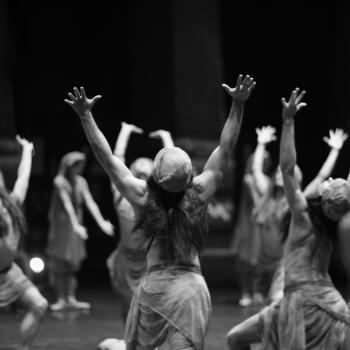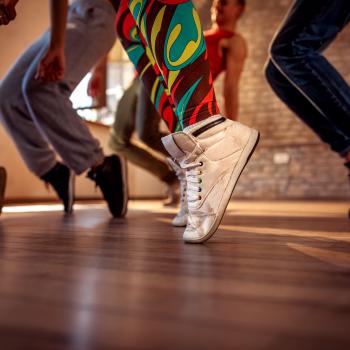Connor Wood

The religious brain is hot stuff right now. Publications as diverse as Science and Newsweek seem to be gaga about how meditation affects the frontal cortex, how praying soothes the amygdala, or how religious belief affects the psyche. But there’s a catch to all this excitement: nearly all the research focuses on either Christian or Buddhist forms of religious practice. Where are the other religions? A team of researchers from Malaysia recently helped to answer this question by studying how Muslim prayer affects alpha waves in the brain, and their results show a profound connection between mind and body.
Neuroscientists, or at least a certain cohort of them, have developed an interest in things religious over the past decade. This surge of interest has been fueled in a large part by the increasing use of brain scanning technology, such as magnetic-resonance imaging and electroencephalograms (EEG), to study how the brain reacts to religious or spiritual practice. But so far, the research has been fairly limited when it comes to religious diversity. Christian religiousness dominates the research on religion and mental health, while Buddhism is the darling of the researchers who study meditation and the brain. Of course, the fact is that Muslims, Hindus, and members of other religions make up more than half of the world’s population, so any theories about how religion affects the brain seem obligated to eventually take these other traditions into account.
Fortunately, a team led by Hazem Doufesh of the University of Malaya’s Department of Biomedical Engineering is blazing the trail, at least in a small way. Doufesh and his colleagues recently published a paper in the journal Applied Psychophysiology and Feedback detailing their EEG study of a small group of Muslim volunteers in the act of praying.
Muslim prayer, or salat, requires the worshiper to move through several distinct bodily postures while reciting specific supplications. The series of postures is fixed, and it’s repeated a number of times for each act of prayer. Worshipers start out standing, then bow at the waist until their upper bodies are parallel with the floor, with their hands pressed against the knees. They then return to a standing position (still reciting supplications, or prayers) before kneeling down to the fully prostrate position – foreheads fully touching the ground. After prostration, worshipers sit up on their knees briefly before returning to a final prostrating. The cycle then starts again. Each stage in this cycle of prayer lasts a few seconds, and the whole cycle lasts between 30 seconds and a full minute.
To study how these different postures might affect brain waves, the researchers fitted the volunteers with EEG monitors around the frontal, central, temporal, parietal, and occipital regions and asked them to complete a series of complete prayer cycles. The volunteers completed one full set of prayers (comprising several cycles) that included both body postures and verbal prayers, or supplications. Then they completed another set with all the postures, but no verbal prayers.
The researchers hypothesized that the volunteers’ brains would show spikes in alpha wave activity during certain phases of the salat, since previous research has strongly suggested a connection between alpha waves – which are associated with relaxation – and religious activities like meditation or prayer. And indeed, they found significant rises in alpha activity in volunteers’ parietal and occipital cortices (the regions near the top and rear of the brain) – but, surprisingly, only during the prostration phase of the salat. In contrast, alpha wave levels didn’t differ much at all between resting state and prayer in the standing, bowing, or kneeling positions.
Interestingly, there was no significant difference between the “actual” salat, or prayer with both postures and supplications, and the “acted” version, which included postures but no spoken prayer. Volunteers showed increased alpha activity during prostrations whether they were actually saying the appropriate prayers or not.
Does this mean that Muslim prayer only really “works” when worshipers are fully prostrate? Or that Muslim believers don’t need to worry about saying their prayers, as long as they go through the bodily motions that accompany them? Those conclusions would probably be premature. Prayer is a multidimensional action, with many different aspects and motivations. Almost nobody takes a break from work to pray so that they can boost their alpha brain waves – instead, people pray for many different reasons that don’t necessarily show up in EEG readings.
However, the fact that a certain body posture seemed to increase alpha waves strongly suggests that performing that posture may increase relaxation, reduce tension, and indicate focus. Doufesh and colleagues suggest that part of the reason for the increased alpha waves during prostrations is the fact that volunteers’ eyes were only inches from the ground, reducing the visual field. Alpha waves have often been associated with closed eyes or reduced visual input, so being forced to stare at only one small region of the floor may explain the prostration-alpha wave connection.
Like any research into neuroscience and religion, though, this doesn’t mean that Muslim salat is “nothing but” the neurological effects of a restricted visual field. Bodies are ineluctably a major part of the religious experience, and the fact that motions or postures of the body can have a concrete effect on the brain that is experienced as spiritual only shows how profound the interaction of consciousness and physiology really is. Religion, for many believers, is a way of engaging with all of life – from mind to relationships to body. The technologies of religion, including prayer, differ profoundly from culture to culture, but each may have something important to tell us about our search for meaning, security, and belonging.











